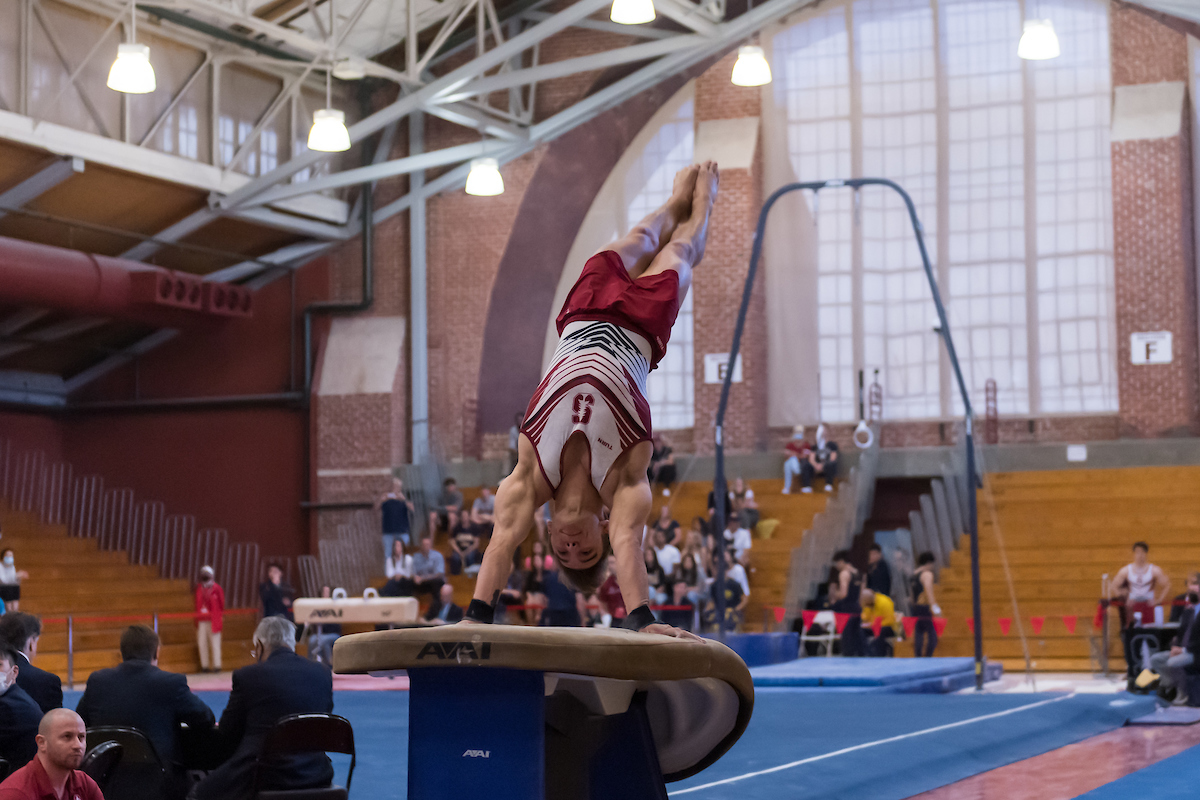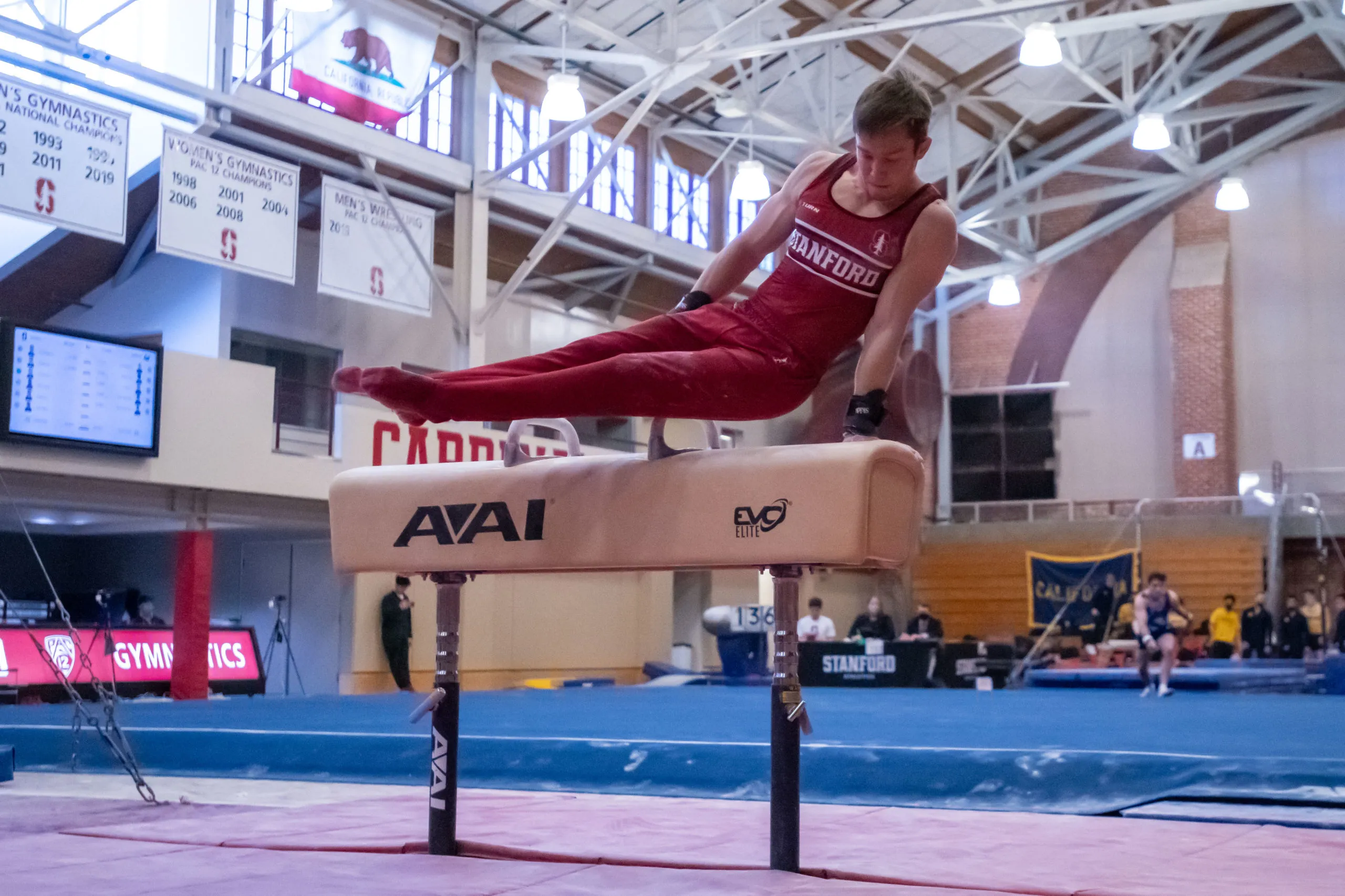When senior Ian Gunther first started posting TikToks in March 2020, his intent did not extend beyond making videos for fun. Like many others on the platform, the onset of the first COVID-19 quarantine period invited him to showcase his unique talents.
For Gunther, who had just earned four NCAA All-American honors in all-around, parallel bars, pommel horse and still rings during a sophomore campaign cut short by the pandemic, this resulted in the posting of videos showcasing impressive gymnastic routines. Within days, his display of body control and physical capabilities had amassed him hundreds of thousands of views.
@ian.gunther I was so nervous for that… I wanted to compete so bad #gymnastics #gymtok #sports #ncaa ♬ original sound – GOD MODE MOMENTS🌀
Similarly, junior Riley Loos never had plans of going viral. While he originally viewed social media as a way to connect with family and friends, the junior now uses the platforms to build his brand, displaying his elite-level gymnast skills.
@rylitight Thanks to y’all I now have a skill named after me! #TheLoos #fyp ♬ Who's Lovin' You – Jackson 5
Together, the pair combine for over 675 thousand followers and 58.5 million likes on TikTok, with numerous videos having reached more than 10 million views.
While these statistics are nothing short of impressive, the levels of success the two have attained as collegiate gymnasts are perhaps even more impressive.
Stanford men’s gymnastics has won back-to-back national championships. The first came in 2019, and the second was in 2021 after the 2020 postseason’s cancellation. Although NCAA men’s gymnastics went without a national champion in 2020, the Cardinal finished the shortened season atop the national rankings.
Now, the team is in a strong position to three-peat this weekend at the NCAA Championships, largely thanks to the efforts of Gunther and Loos.
Gunther, now a senior with eight All-American honors under his belt, was a member of both national championship teams. Loos, who boasts five All-American awards, joined his teammate in bringing home an NCAA championship during the 2021 season.
Despite the success the pair has had at the collegiate level, the following that the gymnasts have developed online drastically outshines the traction they’ve been able to gain around campus or in major media outlets. But why is it that a sport capable of engaging so many viewers on TikTok doesn’t receive the same attention outside of these videos?
“There’s not a lot of love,” said head coach Thom Glielmi. “I think part of it is the sport’s fault… When it’s difficult to understand how the scores are calculated, it doesn’t make it nice for the viewer or spectator if they can’t follow what’s going on.”
Indeed, men’s gymnastics is not a simple sport. A variety of events, a complex scoring system and nuance in routines only obvious to those well-versed in the sport can leave a novice viewer unsure of what’s happening.
“[This challenge] is something that people within the gymnastics community have been trying to figure out for a long time,” said senior Curran Phillips.

But despite the lack of understanding that many viewers have, gymnastics’ inherent entertainment value, as athletes contort their bodies and exhibit otherworldly strength, seems to grasp the attention of the fans that are willing to give it a chance.
“I’ve never had someone go to the gymnastics meet and be unsatisfied with being there,” Phillips said.
Senior Bryan Perla believes the lack of attention the sport receives boils down to the way in which it’s publicized. “It’s just the volume of publicity. If you promote it, there’s an audience for it. But when it’s selectively promoted a little bit or only for big competitions or for this and that… I think that’s why we’re seeing [less interest].”
This lack of publicity is nothing new for Stanford’s program. In years past, much of the attention the team had managed to garner was a product of internal efforts.
“You would think, ‘Be successful and you’ll get a better following.’ But actually, when we were developing the program, the coaching staff did a lot, and we had our athletes do a lot to promote the sport just to get people to come out and see it,” Glielmi said.
Glielmi, a five-time National Coach of the Year recipient now in his 20th season for the Cardinal, has seen a lot during his tenure regarding the program’s attempts to attract fans. “I used to have guys with sandwich boards walking around White Plaza advertising the competition that weekend,” he said. “We would send out our own press releases. We’d send out flyers.”
On a college campus where spectatorship is traditionally dominated by the likes of football and basketball, men’s gymnastics hasn’t been and still isn’t covered by major media outlets in the same way as these other sports.
“The coverage mirrors people’s interests,” Perla said. “Obviously the bigger sports get more mainstream media attention. When you compare it to the other sports, it’s obviously less and there’s no way around that.”
But as the program has continued to develop and produce talented teams year in and year out — finishing in the top five at the NCAA Championships in each of the last 15 seasons it was held — the battle for coverage has reached a crossroads.
Currently ranked the number one team in the country, fresh off their first MPSF Championship title in 10 years and in pursuit of a third consecutive NCAA Championship, the Cardinal have reached new heights. And with this unprecedented success, the time for proper recognition has come — the Cardinal are too good to ignore.
Been building all season for this.
— Stanford Gymnastics (@StanfordMGym) April 3, 2022
𝐀𝐧𝐝 𝐰𝐞'𝐫𝐞 𝐧𝐨𝐭 𝐝𝐨𝐧𝐞!#GoStanford | #ERA | #LND pic.twitter.com/oPQWuDmAgz
This shift has been palpable on campus. Ahead of the MPSF championships in early April, several large inch A-frame signs were placed around heavily-populated student areas to promote the team’s upcoming meet.
Throughout the academic year, nearly every football game and many men’s basketball games had signs put out in a similar fashion, but this was the first time all year that a men’s gymnastics meet had been advertised in such a way.
“Seeing those posters around was obviously awesome for the team,” Perla said. “People were taking pictures of them in White Plaza and sending it to our group message, and people were excited that it was prevalent on campus.”
The signs were effective, and the crowd at Burnham Pavilion for the MPSF Championships created an electric environment. Following the event, the team’s success was no secret around campus.

“Even post-meet, it seemed like the championship results got through to people,” Perla said. “I remember even walking around campus going to class, like, ‘Congrats on winning.’ So the message was heard as far as that competition.”
While gymnastics may be gaining fans in the Stanford community, the sport’s issues persist outside of the campus bubble.
Equity in coverage seems to be something that can improve with time, but the difficulty in understanding the sport still poses a barrier to developing a widespread popularity. Gunther and Loos are attempting to break down this barrier with their social media success.
“When I look through the comments on our videos, [they’re] never from gymnasts,” Loos said. “It’s always new people seeing our videos for the first time and they’re like, ‘Wow, this is really cool.’”
“I get so many comments that are like, ‘I didn’t even know men did gymnastics, this is so cool, I didn’t know humans could do this, I want to start trying to learn this.’” Gunther added.
With videos of difficult routines creating heaps of engagement from viewers that are typically unfamiliar with gymnastics, social media has proven to be an effective medium of attracting new fans.
“I [think] to myself, ‘What way can I frame this so that it’ll be the most interesting to someone who’s never seen gymnastics before,” Gunther explained. “How can I tell a story that’s easily digestible for someone who knows nothing about men’s gymnastics, which is the majority of people.’”
And while these gymnasts have invested time and energy into generating greater spectatorship, their ultimate goal still lies ahead.
This weekend, the team has a chance to earn its third consecutive NCAA Championship and eighth in program history when it competes in Norman, Okla.
“Nobody likes to see a dynasty start coming into place,” Glielmi said. “And I’m not saying we’re a dynasty, but that’s definitely our goal — is to establish that we are here, and we’re going to be here for a while.”
